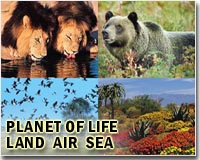 |
Nagoya, Japan (AFP) Oct 30, 2010 Following is a factfile on key points of a global treaty to protect the world's threatened ecosystems that was forged at a UN summit in the Japanese city of Nagoya on Saturday: MISSION: -- Take effective and urgent action to halt the loss of biodiversity in order to ensure that by 2020 ecosystems are resilient and continue to provide essential services. KEY TARGETS TO BE REACHED BY 2020: -- At least 17 percent of land and 10 percent of coastal and marine areas are conserved. -- The extinction of known threatened species has been prevented and their conservation status, particularly of those most in decline, has been improved and sustained. -- Areas under agriculture, aquaculture and forestry are managed sustainably. -- Pollution, including from excess nutrients, has been brought to levels that are not detrimental to ecosystem function and biodiversity. -- Restoration of at least 15 per cent of degraded ecosystems. -- Invasive alien species and pathways are identified, priority species are controlled or eradicated, and measures are in place to manage pathways to prevent their introduction and establishment. ACCESS AND BENEFITS SHARING PROTOCOL -- Establish a legally binding protocol that will allow the "fair and equitable" sharing of the benefits of genetic resources that are found mostly in the biodiverse-rich developing countries. Those resources, such as wild plants in rainforests, are often used by pharmaceutical, drug and other companies in developed countries to make huge profits.
Share This Article With Planet Earth
Related Links Darwin Today At TerraDaily.com
 UN summit poised to seal pact on biodiversity
UN summit poised to seal pact on biodiversityNagoya, Japan (AFP) Oct 29, 2010 Rich and poor nations were poised to forge an ambitious pact to protect threatened ecosystems Friday after breaking a deadlock over genetic treasures derived from places such as the Amazon. The meeting in the central Japanese city of Nagoya aims to produce a roadmap of 20 goals to be achieved over the next decade to contain man's destruction of nature and save the world's rapidly diminishing ... read more |
|
| The content herein, unless otherwise known to be public domain, are Copyright 1995-2010 - SpaceDaily. AFP and UPI Wire Stories are copyright Agence France-Presse and United Press International. ESA Portal Reports are copyright European Space Agency. All NASA sourced material is public domain. Additional copyrights may apply in whole or part to other bona fide parties. Advertising does not imply endorsement,agreement or approval of any opinions, statements or information provided by SpaceDaily on any Web page published or hosted by SpaceDaily. Privacy Statement |